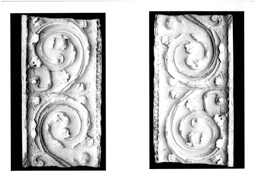Foliate Frieze
Plaster Casts from the North-western Portal of the Cathedral, Rouen, 1880s.
WorkCook and Wedderburn's catalogue of the Ruskin Museum describes this cast as one of 'A collection of plaster casts taken under Ruskin's supervision from decorative sculpture of the best period at Venice and Rouen.' (Works, 30, p. 188)
Ruskin on RouenRuskin's relationship with Rouen stretched back to the Continental tours of his youth. A letter from there written to his father in 1848 gives an impression of the city's formative influence: 'I still feel', he laments, 'that I leave this place Unseen; this is partly, however, owing to my slowness in taking in; I cannot grasp it. Every time I walk into the Square it is new to me. Still I verily believe that I now know more about it than any English architect, and than most French, and I have improved in my drawing in these three months considerably; the different style of Gothic quite beat me at first, and still it does in a great degree.' (Works, 8, pp. xxxi-xxxii).Ruskin later wrote that Rouen was 'a city altogether inestimable for its retention of mediaeval character in the infinitely varied streets in which one half of the existing and inhabited houses date from the fifteenth or early sixteenth century, and the only town left in France in which the effect of old French domestic architecture can yet be seen in its collective groups' (Works, 12, p. 427). Collection of the Guild of St George, Museums Sheffield
Ruskin on SculptureThe reason for the Museum's emphasis on sculpture is given in the 'General Statement Explaining the Nature and Purposes of St George's Guild' (1882):'Sculpture is the foundation and school of painting; but painting, if first studied, prevents, or at least disturbs, the understanding of the qualities of Sculpture. Also, it is possible to convey a perfect idea of the highest quality of Sculpture by casts, and even, in the plurality of cases, to know more of it by a well-lighted cast than can be known in its real situation. But it is impossible to copy a noble painting with literal fidelity; and the carefullest studies from it by the best artists attempt no more than to reproduce some of its qualities reverently, and to indicate what farther charms are to be sought in the original.' (Works, 30, p. 56).Ruskin then states that 'The Sheffield Art Gallery will [...] be unencumbered by any life-size statues whatsoever, and in the niches and lighted recesses of its walls will show only such examples of the art of Sculpture as may best teach the ordinary workman the use of his chisel, and his wits, under such calls as are likely to occur for either in the course of his daily occupations.' (Works, 30, p. 56). |



















